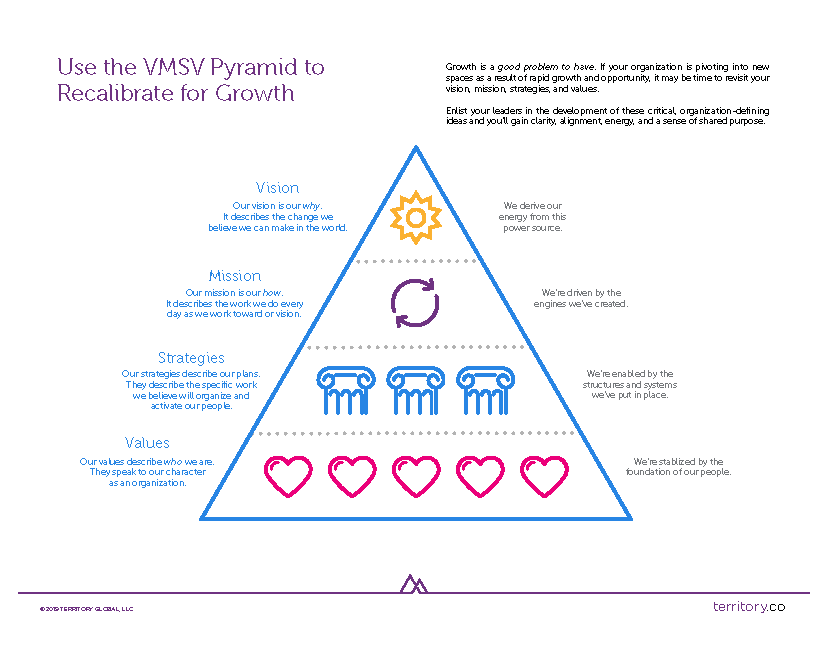The Vision, Mission, Strategy, and Values Extended Universe
Tuesday, October 8, 2024
In 2019, we published an article called “Recalibrate for growth,” which simply and quickly lays out definitions for Mission, Vision, Values, and Strategy.
It lightly touches on all four of these statements that organizations use to manage themselves effectively and links to a tool anyone can use to start building their Mission, Vision, Values, and Strategy. It is one of our most popular articles to date, and understandably so. Everyone will say you need all four of those things. But what are they, exactly? And how do you write great ones?
In honor of that original article, we are planning a series that will delve into all four elements more deeply.
When it comes to tools like these—and listen, Mission, Vision, Values, and Strategy are tools as much as they are anything else—they should work for you and not you for them. One of the reasons they’re worth spending time on and getting right is that, at some point, you want them to become the reality of your organization. You want them to exert some control over the character and practices of the people who work with you. In order for that to happen, they need to be right—or as close to right as you can get them.
We are going to start at the top, with Vision.
Here is how I described a vision statement in the original article:
Your vision is a description of how the future world will be different because of the work your organization does. A vision statement usually describes a moment five to twenty years in the future. Sometimes, particularly for a not-for-profit organization, a described vision may be profoundly aspirational, though it should never be so “pie-in-the-sky” that your team cannot imagine it ever coming to fruition. Oxfam, for example, simply says, “our vision is a just world without poverty.” A vision is also often called a “magnetic north” or a “north star” because it defines a common goal—or direction—for your team.
Why does a vision matter?
Just the other day I was chatting with an executive who expressed concern that vision is too “squishy.”
“How does it become actionable?”
Having encountered a lot of weak, poorly-written vision statements, I understand why this executive felt hesitant. Some of them are actually squishy. But they don’t have to be, and a good one is invaluable for an organization. There are many ways a vision statement can help an organization, but I want to focus on two of the most significant ones: empowerment and inspiration.
Empowerment: your vision as a “North Star”
In the 1960s, Peter Drucker coined the term “knowledge work,” and then later, “knowledge worker,” to describe a new kind of work and a new kind of worker. Today, most of us are knowledge workers—not building widgets in factories, but trading in knowledge that can be used to create and improve products and services.
In that context, one of the most powerful things an organization can cultivate is an empowered workforce. People moving in the same direction, working toward the same ends, but free to use their experience and knowledge to find their own way and create unique solutions. This opens up pathways for innovation—small and large—to bubble up from the people actually doing the work. And it means your people can make good decisions for themselves, increasing efficiency and speed.
A good vision serves as a “magnetic north” for your company—a direction to point everyone and a tool for ensuring they are moving in the right direction. Describing the future you believe will result from your work allows your people to ask themselves, “Do I believe this decision will result in that future?” And if it won’t, it allows them to ask themselves, “What could we do to get there?”
But knowing where to go and wanting to go there are two very different things. The most important thing a vision can do is inspire your people.
Inspiration: giving the right people something to believe in
A good vision is inspiring, but probably not for everyone. And that is a good thing.
Let’s acknowledge right up front that not every organization is Oxfam or the WWF. When I say “inspiration,” I don’t mean “world-changing, not-for-profit, warm and fuzzy,” though I think all those things are wonderful.
Some people are inspired by creating efficiency, some by making record profits, some by providing a great service at a reasonable price, some by creating fun, some by being incredibly expert at something specific, and on and on. People come in a lot of different flavors.
A good vision—one that tells the truth about why you exist as an organization—will help the right people to find you. A large American bank’s vision statement is, “to satisfy all our customers’ financial needs and help them succeed financially.” That’s not a vision that inspires me, but I know there are people who are inspired by it. If that bank means it, the right people will hopefully see and hear that vision and say to themselves, “I want to be part of seeing that come to fruition,” and they’ll join the cause. And when they are there, if that is indeed the work they get to participate in, it will fuel them to keep working hard at it.
One vision to rule them all
So, what is an example of a great vision statement?

Across this series of articles, we’re going to build vision, mission, strategy, and value statements for the group known as “The Fellowship of the Ring.” You may have heard of them from J.R.R. Tolkien’s The Lord of the Rings trilogy.
The group of companions who comprise the Fellowship definitely had clear Vision, Mission, Strategies, and Values, though, of course, they wouldn’t describe them that way. And all of them were challenged to the point of breaking, which is a great analogy to the challenges of running a business. One layer of VMSV pyramid per article, I’m going to take a moment to describe how I think the Fellowship might have described their Vision, Mission, Strategies, and Values.
In short, the Fellowship was formed to destroy a single, very powerful magic ring. The problem was that the ring could only be destroyed in a specific volcano deep in enemy territory. The fellowship comprised elves, dwarves, hobbits, and humans working together. This group of many shapes and sizes—with quite varied strengths and weaknesses—came together because a great evil was rising, threatening to overtake and destroy everything. The ring needed to be destroyed so the evil power could be broken.
Their vision was simple: a Middle Earth where every elf, dwarf, hobbit, and human (and any other peaceable people) could live in peace and prosperity, untouched by evil.
This brought them together, motivated them, gave them a sense of purpose and something to aim for, even as their Fellowship was torn apart, and ultimately helped them succeed. They were empowered to work toward that vision even when they were separated from each other, and they were inspired by it in ways that enabled them to risk their lives for success.
Don’t get bogged down
When you are ready to start building a vision statement for your organization, don’t get bogged down trying to hit perfection. A vision statement should be pithy and memorable but it shouldn’t have to perfectly explain everything in a single sentence. You can write paragraphs to clarify your vision statement on your “about us” page, in your employee training, and wherever else it makes sense.
You need something your people can carry around with them as a reminder of that larger idea, and it doesn’t have to contain the whole universe.
What now?
If you’re hoping to build a better vision statement today, feel free to grab our VMSV Pyramid and give it a spin. If you want more information, reach out. We love helping organizations get better through collaboration. As a matter of fact, our vision is:





